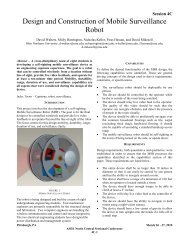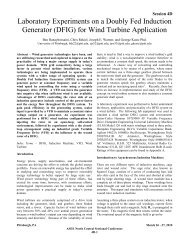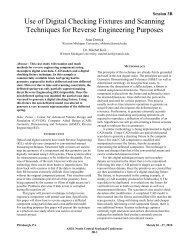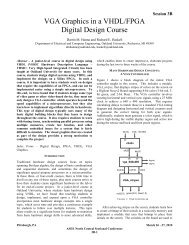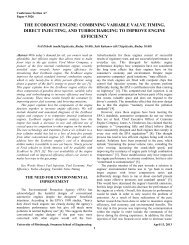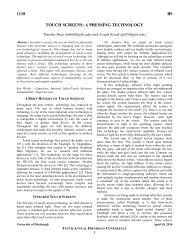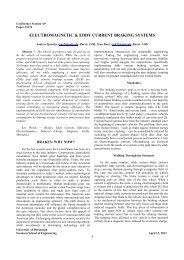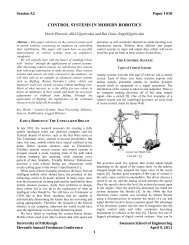Engineered Cementitious Composites
Engineered Cementitious Composites
Engineered Cementitious Composites
You also want an ePaper? Increase the reach of your titles
YUMPU automatically turns print PDFs into web optimized ePapers that Google loves.
Session A5<br />
Paper #3204<br />
ENGINEERED CEMENTITIOUS COMPOSITES: APPLICATIONS AND<br />
IMPACT OF HIGH TENSILE, SELF-HEALING CONCRETE<br />
Jayne Marks (jam347@pitt.edu, Vidic 2:00), Jon Conklin (jjc105@pitt.edu, Vidic 2:00)<br />
Abstract— <strong>Engineered</strong> <strong>Cementitious</strong> Composite, or ECC, is<br />
a unique type of cement mixture that was initially developed<br />
by Victor Li at the University of Michigan in 2001 [1]. It<br />
improves upon current concrete mixes and Fiber Reinforced<br />
Concrete (FRC) types due to its “unique composition of low<br />
volume fibers and variable composites,” that give it a high<br />
tensile strength and the ability to repair itself [2]. The<br />
concrete mix was created based mainly on the interactions<br />
between the microfibers included in the mixture and the<br />
other materials present (the matrix). These interactions<br />
create flat steady state cracking of the concrete when under<br />
stress [3]. This type of cracking better protects the concrete<br />
from the introduction of solvents and corrosive elements<br />
while also promoting the reactions that cause self-healing,<br />
and these properties are what set <strong>Engineered</strong> <strong>Cementitious</strong><br />
Composite apart from the concrete currently in use today.<br />
The improvement to concrete <strong>Engineered</strong> <strong>Cementitious</strong><br />
Composite displays has many societal applications that can<br />
help improve the current state of the world’s structures<br />
including longer lasting infrastructure, less repair costs, and<br />
more versatile physical properties of structures it is used in<br />
[4].<br />
This paper will discuss experiments performed to test<br />
tensile strength, compression resistance, and shrinkage of<br />
<strong>Engineered</strong> <strong>Cementitious</strong> Composite concrete based on<br />
variations in the composite make up of <strong>Engineered</strong><br />
<strong>Cementitious</strong> Composite that cause it to differ from other<br />
concretes and Fiber Reinforced Concretes in the areas of<br />
ductility, durability, permeability, and other important<br />
properties. It will also explore the benefits of application to<br />
society and economic advantages while also taking into<br />
account environmental impacts and cost by citing specific<br />
examples of <strong>Engineered</strong> <strong>Cementitious</strong> Composite use in<br />
society today; such as seismic dampening support columns<br />
in skyscrapers of Japan, or dam overlay repair.<br />
Key Words— Cement, Concrete, ECC, <strong>Engineered</strong><br />
<strong>Cementitious</strong> Composite, Fiber Reinforced Concrete, Victor<br />
Li<br />
CONCRETE AS IT STANDS<br />
Concrete is the most widely used construction material in<br />
the world [5]. Not only is it used on highways and<br />
buildings, concrete is a vital component of many other<br />
structures necessary for the function of society such as<br />
underground transit, wastewater treatment, marine<br />
structures, and bridges. Every year, the use of concrete for<br />
construction projects globally exceeds 12 billion tons [2]. To<br />
put that into perspective, there are roughly 7 billion people<br />
on the planet, averaging out to 1.7 tons of concrete per<br />
person used each year Concrete is one of the most<br />
prominently used construction resources, yet the main types<br />
of concrete in use tend to have major issues that hinder their<br />
performance. Concrete is fundamentally a mixture of<br />
aggregates and paste. The aggregates are sand and gravel or<br />
crushed stone; the paste is water and Standard Portland<br />
cement. When the average person thinks of concrete, this<br />
basic mixture is typically what they are thinking of.<br />
However, this particular type of concrete has drawbacks that<br />
make it a less than ideal choice for such an important<br />
resource. This traditional concrete may be strong initially,<br />
but it tends to be very brittle and cracks easily under<br />
mechanical and environmental loads [5]. The cracks that<br />
develop tend to be very large, allowing sulfates and<br />
corrosive agents to permeate through and damage any inner<br />
steel structures the concrete may be covering. In the event<br />
of a catastrophe such as an earthquake, a damaged section of<br />
concrete could be the difference between a building standing<br />
or collapsing.<br />
For this reason, it is necessary to consider an ideal<br />
concrete mixture that would retain the strength of basic<br />
concrete, while better handling the stresses of the<br />
environment that these types of structures experience on a<br />
daily basis. This ideal concrete would need to be ductile, or<br />
able to deform under tensile stress, so it would not crack and<br />
crumble under mechanical loads, but it would have to retain<br />
a large tensile (or bending) strength. The concrete should not<br />
be easily permeated so the infrastructure is kept away from<br />
harmful chemicals, and it should also be easily repaired if<br />
damage is sustained.<br />
One improvement that has been used commercially since<br />
the 1900s is the addition of small fibers, usually made of<br />
steel or glass, to the concrete mixture. This addition<br />
increases the bending strength of the material due to the<br />
flexible nature of the fibers. These concretes are known as<br />
Fiber Reinforced Concrete (FRC), and while this does solve<br />
some of the problems presented by regular concrete, it was<br />
not until 2001 that an ideal concrete solution was developed.<br />
This new MIXTURE incorporates the strength of regular<br />
concrete with the flexibility of Fiber Reinforced Concrete. It<br />
also exhibits a rather useful quality that far exceeded the<br />
ability of the other two options. This concrete mixture is<br />
called <strong>Engineered</strong> <strong>Cementitious</strong> Composite (ECC): the<br />
strong, flexible, and self-healing concrete [3].<br />
WHAT IS ENGINEERED CEMENTITIOUS<br />
COMPOSITE?<br />
University of Pittsburgh<br />
Swanson School of Engineering March 7, 2013<br />
1
Jayne Marks<br />
Jon Conklin<br />
According to a research article published by the<br />
University of Michigan Transportation Research Record,<br />
“<strong>Engineered</strong> <strong>Cementitious</strong> Composite is “a special type of<br />
high performance fiber reinforced concrete containing a<br />
small amount of short random fibers micromechanically<br />
designed… to achieve high damage tolerance under severe<br />
loading and high durability under normal service conditions”<br />
[5]. It was developed in 2001 by Dr. Victor Li at the<br />
University of Michigan. However, <strong>Engineered</strong> <strong>Cementitious</strong><br />
Composite is no longer confined to the academic research<br />
laboratory; it is finding its way into precast plants,<br />
construction sites, and repair and retrofitting jobs in<br />
countries including Japan, South Korea, Australia,<br />
Switzerland, Canada, and the United States [4]. What<br />
makes <strong>Engineered</strong> <strong>Cementitious</strong> Composite different from<br />
other regular and fiber reinforced concretes are the unique<br />
properties associated with its specially tailored composites.<br />
These properties include a smaller crack width, superior<br />
tensile strength, significantly higher ductility, self-healing<br />
properties, and low fiber volume [5]. All of these properties<br />
contribute to improving the safety, strength, and<br />
sustainability of the structures it’s implemented into.<br />
CHARACTERISTICS AND PROPERTIES<br />
OF ENGINEERED CEMENTITIOUS<br />
COMPOSITE<br />
The introduction and application of <strong>Engineered</strong><br />
<strong>Cementitious</strong> Composite would be pointless without the very<br />
specific qualities and strengths that it exhibits. These special<br />
qualities are based upon its material make up and the<br />
interactions with the surrounding environment it<br />
experiences. The characteristics break down into the<br />
physical strength and interactions that <strong>Engineered</strong><br />
<strong>Cementitious</strong> Composite undergoes, along with the chemical<br />
reactions and properties that allow the process of selfhealing<br />
to occur. These physical properties include<br />
remarkable tensile (or bending) strength and ductility, which<br />
allow for one of the more important interactions in the<br />
concrete itself: micro-cracking. The process of microcracking<br />
exponentially increases the tensile strength and<br />
remains within a low degree of permeability. This low<br />
permeability reduces the effects associated with the<br />
absorption of chemicals which include the weakening of any<br />
underlying support structures and erosion of the concrete<br />
itself [4]. This increases the lifespan and repair cycle of the<br />
concrete and the structure as a whole, while also creating the<br />
conditions that allow specific chemical reactions to occur<br />
that help to fill in the cracks of the concrete.<br />
Physical Properties and Stress Interactions of<br />
<strong>Engineered</strong> <strong>Cementitious</strong> Composite<br />
<strong>Engineered</strong> <strong>Cementitious</strong> Composite concrete exhibits<br />
many natural, physical qualities that allow it to be applied in<br />
place of standard fiber reinforced concrete as a more<br />
dependable, long-term replacement. These characteristics<br />
include its low permeability along with high tensile strength,<br />
flexibility, and resistance to corrosion and spalling, or the<br />
fragmentation of the concrete under stress [3].<br />
When stress is introduced to a sample of <strong>Engineered</strong><br />
<strong>Cementitious</strong> Composite, the major transfer of this stress is<br />
through the formation of micro-cracks in response to a<br />
tensile strain. The nature of these cracks is different from<br />
that of the cracks seen on other fiber reinforced concretes<br />
due to the fact that flat steady state micro-cracks are formed<br />
as opposed to localized Griffith crack propagation [3]. The<br />
former of the stress responses is ideal because when this<br />
type of micro-cracking occurs, it forms multiple, uniform<br />
cracks over a small area, whereas Griffith crack propagation<br />
forms large jagged cracks that are localized and harmful to<br />
the strength and permeability of the concrete. Under the<br />
conditions of steady state flat crack propagation, a process<br />
known as plasticity occurs where the material strength is<br />
higher after the first crack is formed and increases linearly to<br />
the final tensile strength factor. These cracks in <strong>Engineered</strong><br />
<strong>Cementitious</strong> Composite then follow simple formulae of<br />
crack potential and width that allows <strong>Engineered</strong><br />
<strong>Cementitious</strong> Composite to form smaller crack widths.<br />
These equations used to predict things such as crack width,<br />
strength, length, and flexibility can be found below.<br />
P=(ε sh -(ε e +ε cp +ε i )) (1)[3]<br />
This equation demonstrates that as the sum of the elastic<br />
tensile strain capacity (ε e ), tensile creep strain (ε cp ), and<br />
strain capacity (ε i ) increase or decrease relative to the<br />
shrinkage strain (ε sh ), the cracking potential (P) will increase<br />
or decrease respectively.<br />
L ch =EG f /σ t<br />
2<br />
(2)[3]<br />
This equation demonstrates that as the tensile strength (σ t )<br />
increases or decreases relative to the product of the Young’s<br />
modulus (E) and the fracture energy (G f ), the Hillerborg’s<br />
material characteristic length (L ch ) will decrease or increase<br />
respectively.<br />
W=L(P/(1-L/2L ch ) (3)[3]<br />
In equation 3, crack width (W) is proportional to the<br />
product of the crack length (L) and the crack potential<br />
divided by the crack length minus one divided by the<br />
Hillerborg’s material characteristic length. This relates that a<br />
larger cracking potential will result in a greater crack width<br />
which is shown to be the opposite for <strong>Engineered</strong><br />
<strong>Cementitious</strong> <strong>Composites</strong>.<br />
University of Pittsburgh<br />
Swanson School of Engineering March 7, 2013<br />
2
Jayne Marks<br />
Jon Conklin<br />
These equations also show that when cracking potential<br />
(P) is greater than or equal to zero, a single crack forms in<br />
the concrete with a proportional width (W) and the material<br />
will have a larger strain capacity as the number of cracks<br />
increases until the strain capacity value reaches an ultimate<br />
tensile strength. <strong>Engineered</strong> <strong>Cementitious</strong> Composite has a<br />
large strain capacity of about five percent (500 times that of<br />
standard concrete), and an extremely low chance of the<br />
formation of localized fracture damage [3].<br />
The formation of these micro-cracks creates a unique<br />
resistance to the absorption of water and chloride ions which<br />
pose the greatest threat to the underlying structure of any<br />
reinforced concrete. Through experimentation and analysis,<br />
it was determined that <strong>Engineered</strong> <strong>Cementitious</strong> Composite<br />
exhibits crack width well under the threshold of permeability<br />
for water and chloride ions under accelerated corrosion<br />
testing. When compared to that of normal concrete over a 14<br />
week freeze thaw cycle, the traditional concrete was<br />
deteriorated at such a rapid rate, that it was removed from<br />
testing after five weeks. The <strong>Engineered</strong> <strong>Cementitious</strong><br />
Composite sample went on to complete the 14 weeks with<br />
no degradation of the surface or strength. Similarly, a 26<br />
week test of <strong>Engineered</strong> <strong>Cementitious</strong> Composite was<br />
conducted in a high temperature and alkaline environment,<br />
which, when complete, showed that the <strong>Engineered</strong><br />
<strong>Cementitious</strong> Composite dropped in tensile strain from 4.5%<br />
to 2.75%. While this seems to show a significant degradation<br />
in the concrete, similar traditional concretes are still 250<br />
times weaker in comparison [6].<br />
Material makeup of <strong>Engineered</strong> <strong>Cementitious</strong> Composite<br />
also plays a part in the properties of strength and<br />
micromechanical interactions. The introduction of certain<br />
composites to the mix of <strong>Engineered</strong> <strong>Cementitious</strong><br />
Composite results in a greater compressive and tensile<br />
strength, while also increasing the bond strength between the<br />
underlying structure and the concrete [4]. The increase in<br />
compressive and tensile strength means that <strong>Engineered</strong><br />
<strong>Cementitious</strong> Composite is able to experience large axially<br />
directed pushing forces and lateral stretching or pulling<br />
forces without showing serious deformation or sharp breaks.<br />
This ductility is similar to that seen in metals. The flexibility<br />
of the material can be seen in Figure 1 below.<br />
FIGURE 1<br />
<strong>Engineered</strong> <strong>Cementitious</strong> Composite’s flexibility<br />
exemplified [7]<br />
This has been experimented on multiple times and has<br />
reached a point of customization to the project that would<br />
allow a longer period between repairs than is already<br />
expected for similar applications of <strong>Engineered</strong><br />
<strong>Cementitious</strong> Composite. One such experiment consisted of<br />
the addition and substitution of different proportion of glass<br />
beads to specifically form a lightweight, coarse aggregate<br />
that would lower the density in a uniform manner. This<br />
customized, lightweight version of <strong>Engineered</strong> <strong>Cementitious</strong><br />
Composite showed significant improvement in tensile and<br />
compressive strength, while allowing for a product that<br />
provided 40 MPa (mega-Pascal) of compressive strength and<br />
4MPa of tensile strength on average (much higher than other<br />
concretes) [8]. However, the cost and practicality of certain<br />
mixtures is regarded as a serious factor to consider when<br />
application of <strong>Engineered</strong> <strong>Cementitious</strong> Composite is<br />
compared to that of standard fiber reinforced concretes.<br />
Along with this same experiment, a sample that had a<br />
density of .93 g/cm 3 , less than that of water, was deemed<br />
acceptable for application in seismic dampeners with a<br />
tensile strength of 2.85MPa and a compressive strength of<br />
28.1MPa [8]. This relationship shows that at a certain point,<br />
the relationship between density and the strength of<br />
<strong>Engineered</strong> <strong>Cementitious</strong> Composite will drop to a point that<br />
resembles the compressive strength of standard concrete<br />
while retaining the tensile properties that makeup the major<br />
benefits of the application of <strong>Engineered</strong> <strong>Cementitious</strong><br />
Composite.<br />
Chemical Interactions of Self-Healing <strong>Engineered</strong><br />
<strong>Cementitious</strong> Composite<br />
While the durability of <strong>Engineered</strong> <strong>Cementitious</strong><br />
Composite is due to a low permeability and diffusion rate,<br />
along with a high tensile and compressive strength, the long<br />
lifespan is also due to a chemical process of self-healing that<br />
occurs inside the micro-cracks of the concrete. During the<br />
early stages of cracking (fewer than fifty micrometers), the<br />
concrete will engage automatically in a self-healing reaction<br />
University of Pittsburgh<br />
Swanson School of Engineering March 7, 2013<br />
3
Jayne Marks<br />
Jon Conklin<br />
that will mechanically fill in the micro-cracks. It takes place<br />
directly in the crack and under a multitude of environmental<br />
conditions ranging from freezing-thawing cycles to chloride<br />
submersion which allows the self-healing to be dependable<br />
in real life applications. This process of self-healing stems<br />
from the carbonation of the calcium in the cement matrix,<br />
but only occurs in the presence of specific acidity levels of<br />
the water and calcium ion concentration at the crack surface.<br />
As water moves more slowly through cracks of a smaller<br />
width, as opposed to quickly through larger cracks in regular<br />
Fiber Reinforced Concretes, pH levels will rise as carbonate<br />
precipitation occurs. This reaction is shown in equation<br />
number 4 below [3].<br />
Ca2 + + HCO 3<br />
-<br />
CaCO 3 +H + (7.58) (4)[3]<br />
As the water, which contains carbon dioxide, penetrates<br />
the pores of hardened cement paste even deeper, it dissolves<br />
additional calcium ions from the calcium hydroxide. This<br />
then raises the pH value of the solution even more towards<br />
the ideal pH creating a more favorable environment for the<br />
self-healing process. The formation of CaCO 3 is the<br />
compound that will ultimately fill in the micro-cracks in<br />
which the reaction is occurring.[3]<br />
Experimentation has shown that a sample of <strong>Engineered</strong><br />
<strong>Cementitious</strong> Composite put under tensile strain and then<br />
subject to three wet dry cycles, will successfully fill a one<br />
hundred micrometer crack with calcium carbonate crystals.<br />
Additional testing in this experiment also showed that the<br />
introduction of fly ash to the <strong>Engineered</strong> <strong>Cementitious</strong><br />
Composite mixture would decrease average crack width to<br />
around ten micrometers, thus promoting a quicker and more<br />
filled self-healing sample [9]. The results of this experiment<br />
can be seen in Figure 2.<br />
FIGURE 2<br />
The process of self-healing that <strong>Engineered</strong> <strong>Cementitious</strong><br />
Composite undergoes during this time has little effect on the<br />
tensile strength of the concrete: lowering the overall strength<br />
from 4.5% to 3%, a value well beyond that of standard fiber<br />
reinforced concrete [3]. Along with this, the introduction of<br />
additives such as fly ash (an industrial waste resulting from<br />
coal-fired thermoelectric power generation) to <strong>Engineered</strong><br />
<strong>Cementitious</strong> Composite would allow it to be applied to<br />
situations where a more consistent self-healing process<br />
would be observed. Certain other additives create different<br />
customized properties of <strong>Engineered</strong> <strong>Cementitious</strong><br />
Composite, including the ability to be sprayed as a much<br />
lighter material, higher tensile strength, or higher<br />
compressive strength. These various forms of <strong>Engineered</strong><br />
<strong>Cementitious</strong> Composite make it much more applicable to<br />
various commercial needs.<br />
APPLICATIONS OF ENGINEERED<br />
CEMENTITIOUS COMPOSITE AND ITS<br />
AFFECTS ON SOCIETY<br />
The many positive qualities of <strong>Engineered</strong> <strong>Cementitious</strong><br />
Composite have been repeatedly exemplified in a laboratory<br />
setting, but the superior physical characteristics also pose<br />
many benefits to society through application. <strong>Engineered</strong><br />
<strong>Cementitious</strong> <strong>Composites</strong> pave the way for many possible<br />
improvements to the current standing of concrete, and in<br />
some cases, <strong>Engineered</strong> <strong>Cementitious</strong> Composite has already<br />
been implemented in construction projects. These cases<br />
exhibit structures that are more resilient and less susceptible<br />
to damages. Because sustainability is the capacity to endure,<br />
the more durable and longer lasting structures associated<br />
with the use of <strong>Engineered</strong> <strong>Cementitious</strong> Composite<br />
contribute not only to the sustainability of the world’s<br />
infrastructure, but also to a reduction in maintenance and<br />
repair costs, a better environmental impact, and an overall<br />
improvement of the safety of structures constructed with<br />
concrete.<br />
<strong>Engineered</strong> <strong>Cementitious</strong> Composite a) before healing and<br />
b) after healing [9]<br />
Cost/Benefit Analysis<br />
When comparing costs of <strong>Engineered</strong> <strong>Cementitious</strong><br />
Composite and regular concrete, it is important to not only<br />
look at the initial manufacturing cost of the product, but to<br />
also consider the cost over the span of the concrete’s<br />
lifetime. If the initial costs are compared, regular concrete<br />
does exhibit a lower starting value (about three times less<br />
than <strong>Engineered</strong> <strong>Cementitious</strong> Composite), but this initial<br />
benefit comes at the price of quality [7]. The prices may<br />
differ in favor of regular concrete, but the long term<br />
financial benefits are substantial enough to drive the market<br />
in favor of <strong>Engineered</strong> <strong>Cementitious</strong> Composite. The reason<br />
for the gap in startup price arises from the composition of<br />
<strong>Engineered</strong> <strong>Cementitious</strong> Composite. Unlike regular cement,<br />
University of Pittsburgh<br />
Swanson School of Engineering March 7, 2013<br />
4
Jayne Marks<br />
Jon Conklin<br />
<strong>Engineered</strong> <strong>Cementitious</strong> Composite contains tiny fibers that<br />
drive up the price of production, and while other Fiber<br />
Reinforced Concrete’s use steel fibers, <strong>Engineered</strong><br />
<strong>Cementitious</strong> Composite typically uses more expensive<br />
poly-vinyl alcohol (PVA) fibers. These are fibers made from<br />
poly-vinyl alcohol or a type of plastic [3]. These PVA fibers<br />
are more expensive to use, but they weigh considerably less<br />
than the steel or glass fibers used in ordinary Fiber<br />
Reinforced Concrete Similarly, <strong>Engineered</strong> <strong>Cementitious</strong><br />
Composite has an extremely low fiber volume compared<br />
with other Fiber Reinforced Concrete. Both of these factors<br />
reduce the weight of <strong>Engineered</strong> <strong>Cementitious</strong> Composite<br />
compare to other Fiber Reinforced Concrete, and because it<br />
is typical to price concrete based on mass, it is possible that<br />
using <strong>Engineered</strong> <strong>Cementitious</strong> Composite could be cheaper<br />
than Fiber Reinforce Concrete. However both are still<br />
considerably more expensive than basic concrete which<br />
includes no fibers. In order to lower the cost of <strong>Engineered</strong><br />
<strong>Cementitious</strong> composite, the expensive cement that is used<br />
in the mixture to make the paste component of the concrete<br />
can easily be replaced with a less expensive alternative such<br />
as fly ash. This substitution would cause no drastic changes<br />
in function [10, 2]. The practice of adding fly ash has<br />
already been implemented and has been shown to include<br />
benefits other than cost reduction such as less environmental<br />
pollution. The cost of manufacturing <strong>Engineered</strong><br />
<strong>Cementitious</strong> Composite may be high, but in the long term,<br />
the concrete proves to help reduce expenses.<br />
The main long term financial benefit of using <strong>Engineered</strong><br />
<strong>Cementitious</strong> Composite is the reduction of the maintenance<br />
costs when compared to regular concrete. Because<br />
<strong>Engineered</strong> <strong>Cementitious</strong> Composite is much more sturdy,<br />
less brittle, more flexible, and self-healing, it requires repairs<br />
less frequently than other concretes. The brittle nature of<br />
regular concretes leads to “repeated cycles of short-term<br />
repair scenarios which result in increased consumption of<br />
repair materials and fuels”[10]. Dr. Victor Li stated that “a<br />
bridge built with traditional concrete will average $350,000<br />
a year in maintenance, user, and environmental costs –its so<br />
called “life-cycle cost”—over 60 years. The same bridge, if<br />
built with [<strong>Engineered</strong> <strong>Cementitious</strong> Composite], ought to<br />
have a 50% lower life-cycle cost. That would add up to a<br />
savings of $11 million, potentially justifying the much<br />
higher initial price tag.”[7]. Similarly, structures in better<br />
condition mean less financial repercussions for those using<br />
them. Currently 32% of US major roads are in poor or<br />
mediocre condition [2]. Driving on these roads costs drivers<br />
an average of $22 extra per driver in vehicle operating costs<br />
each year totaling $41.5 billion. The implementation of<br />
<strong>Engineered</strong> <strong>Cementitious</strong> Composite would save money in<br />
the long term, and that compensates for any discrepancy<br />
between initial manufacturing costs of <strong>Engineered</strong><br />
<strong>Cementitious</strong> Composite, Fiber Reinforced Concrete, and<br />
regular concrete.<br />
Practical Applications of <strong>Engineered</strong> <strong>Cementitious</strong><br />
Composite<br />
The superiority of <strong>Engineered</strong> <strong>Cementitious</strong> Composite<br />
not only financially, but in overall quality and performance,<br />
has caused the beginnings of implementation to the<br />
commercial concrete business. <strong>Engineered</strong> <strong>Cementitious</strong><br />
Composite has been used in a skyscraper in Japan, a mall in<br />
Canada, and a bridge in Michigan. In the specific case of the<br />
bridge, <strong>Engineered</strong> <strong>Cementitious</strong> Composite was used as a<br />
link slab to connect portions of the bridge deck as seen in<br />
Figure 3.<br />
FIGURE 3<br />
Section of Michigan bridge replaced by <strong>Engineered</strong><br />
<strong>Cementitious</strong> Composite [6]<br />
Bridges experience necessary movement such as<br />
expansion and contraction due to temperature, vehicle loads,<br />
and settlement. It must be able to withstand all of these<br />
stresses, while also exhibiting good riding quality and<br />
minimal noise. Normally, sections of the bridge deck are<br />
connected using mechanical expansion joints, however,<br />
these metal joints can easily fall into disrepair and begin to<br />
deteriorate the bridge structure itself. In the case of the<br />
bridge in Michigan, the four span simply supported steel<br />
girder bridge with a nine-inch thick reinforced concrete deck<br />
constructed in 1976 underwent construction to replace the<br />
deck and include an <strong>Engineered</strong> <strong>Cementitious</strong> Composite<br />
slab. This was the initial implementation of <strong>Engineered</strong><br />
<strong>Cementitious</strong> Composite. Two days after patching, the<br />
<strong>Engineered</strong> <strong>Cementitious</strong> Composite showed no visible<br />
cracking, yet the concrete patch had a clearly visible crack<br />
approximately 300mm wide. Ten months after patching, the<br />
maximum <strong>Engineered</strong> <strong>Cementitious</strong> Composite crack width<br />
was 50μm while the section of concrete was described as<br />
“severely deteriorating.” Five winters after installation, the<br />
concrete needed re-repaired, but the <strong>Engineered</strong><br />
<strong>Cementitious</strong> Composite still only showed small cracks [10].<br />
The reason for this difference in performance is due to the<br />
flexibility of the <strong>Engineered</strong> <strong>Cementitious</strong> Composite. It is<br />
better able to handle the thermal expansion and contraction<br />
of the bridge. Also, the micro-cracks that do develop are<br />
either self-healed or small enough to not affect the<br />
functioning of the bridge.<br />
University of Pittsburgh<br />
Swanson School of Engineering March 7, 2013<br />
5
Jayne Marks<br />
Jon Conklin<br />
This unique outperformance is the case for all examples<br />
of <strong>Engineered</strong> <strong>Cementitious</strong> Composite application. Because<br />
it can be cast, extruded (pushed through a die of desired<br />
shape and cross sectional area), or sprayed, and has unique<br />
self-healing capabilities, <strong>Engineered</strong> <strong>Cementitious</strong><br />
Composite is a good choice for a long lasting repair material.<br />
In an experiment involving damaged concrete beams that<br />
were repaired with <strong>Engineered</strong> <strong>Cementitious</strong> Composite, it<br />
was found that <strong>Engineered</strong> <strong>Cementitious</strong> Composite actually<br />
increased the tensile strength of the beam to levels higher<br />
than the original, undamaged beam [11]. This can be seen in<br />
Figure 4 below.<br />
from Portland cement, and hot mixed asphalt (HMA) on<br />
important environmental statistics.<br />
FIGURE 5<br />
FIGURE 4<br />
Energy use for regular concrete, <strong>Engineered</strong> <strong>Cementitious</strong><br />
Composite, and HMA (hot mix asphalt) compared [2]<br />
FIGURE 6<br />
Regular concrete beam (left) compared to <strong>Engineered</strong><br />
<strong>Cementitious</strong> Composite beam (right) during a strength<br />
loading experiment [4]<br />
Although <strong>Engineered</strong> <strong>Cementitious</strong> Composite has a<br />
higher price than regular concrete, using even small amounts<br />
to repair beams, dams, bridges, and other construction<br />
projects or to coat undamaged structures is an investment in<br />
the stability of the structure. This creates a more sustainable<br />
building material, reduces the price of repairs and the<br />
amount of materials used for repairs, and helps to lower the<br />
negative impact on the environment<br />
Sustainability and Environmental Impact of <strong>Engineered</strong><br />
<strong>Cementitious</strong> <strong>Composites</strong><br />
“Cement is responsible for 3% of global greenhouse gas<br />
emissions.” Every time 1 ton of cement is produced, 1 ton<br />
of CO 2 is released as well [2]. When structures like roads are<br />
built with regular cement, they need to be repaired more<br />
frequently. This uses more cement which releases more<br />
greenhouse gases into the atmosphere. While a road is being<br />
repaired, the traffic in that area increases due to<br />
constructions and road closings. This congestion leads to<br />
increased fuel use and emissions [2]. Using <strong>Engineered</strong><br />
<strong>Cementitious</strong> Composite can help to slightly decrease this<br />
environmental impact which improves the overall<br />
sustainability of the project. Figures 5 and 6 compare<br />
<strong>Engineered</strong> <strong>Cementitious</strong> Composite, concrete made only<br />
Carbon Dioxide production due to concrete, <strong>Engineered</strong><br />
<strong>Cementitious</strong> Composite, and HMA (hot mix asphalt<br />
compared) [2]<br />
These figures demonstrate the decrease in energy use and<br />
CO 2 emissions that can be achieved by using <strong>Engineered</strong><br />
<strong>Cementitious</strong> Composite, however, there is still room for<br />
improvement.<br />
The current accepted mixture of <strong>Engineered</strong><br />
<strong>Cementitious</strong> Composite includes a significant amount of<br />
cement so the adverse environmental effects associated with<br />
this material are still present in <strong>Engineered</strong> <strong>Cementitious</strong><br />
Composite. However, by substituting this with industrial<br />
waste such as sands, kiln dust, and fly ash, the<br />
environmental effects of the cement production would be<br />
reduced while also disposing of waste. “70% of <strong>Engineered</strong><br />
<strong>Cementitious</strong> Composite’s composites may be replaced<br />
without reducing critical mechanical performance<br />
characteristics [10].” Also, as stated previously, the fly ash<br />
would not only lessen the negative environmental impacts of<br />
<strong>Engineered</strong> <strong>Cementitious</strong> Composite manufacturing, it may<br />
also help to facilitate self-healing reactions better than in<br />
regular <strong>Engineered</strong> <strong>Cementitious</strong> Composite mixtures.<br />
Because sustainability is the ability of a process,<br />
method, or structure to endure over time and to support the<br />
endurance of society, the reduction of negative<br />
University of Pittsburgh<br />
Swanson School of Engineering March 7, 2013<br />
6
Jayne Marks<br />
Jon Conklin<br />
environmental impacts, the increase in the life-span of<br />
structures using <strong>Engineered</strong> <strong>Cementitious</strong> Composite, and<br />
the decrease in the amount of resources needed to repair<br />
these structures all show that <strong>Engineered</strong> <strong>Cementitious</strong><br />
Composite is a sustainable alternative to regular concrete<br />
Using <strong>Engineered</strong> <strong>Cementitious</strong> Composite as a commercial<br />
replacement for cement and Fiber Reinforced Concretes<br />
would lessen the environmental footprint of the cement<br />
industry through not only the reduction of emissions during<br />
manufacturing, but also through the reduction of repair<br />
materials necessary to keep structural conditions safe.<br />
The Ethics Behind <strong>Engineered</strong> <strong>Cementitious</strong> Composite<br />
The most important aspect of any new building material is<br />
its safety. If <strong>Engineered</strong> <strong>Cementitious</strong> Composite was not<br />
safe, all of the previously stated characteristics would be<br />
irrelevant. In the American Society of Civil Engineers<br />
(ASCE) code of ethics, Canon #1 states that “engineers shall<br />
hold paramount the safety, health and welfare of the public”<br />
[12]. When using concrete, especially for load bearing<br />
structures such as buildings and bridges, it is absolutely<br />
essential that the concrete be able to hold up the weight of<br />
that structure. If the concrete cracks and crumbles under<br />
stress lower than the stress expected to be experienced<br />
during use, the possibility of structural failure could result.<br />
This can cause increased repair costs, malfunctions of<br />
essential societal systems like dams and water treatment<br />
plants, injury, or even death. <strong>Engineered</strong> <strong>Cementitious</strong><br />
Concrete has been experimentally proven multiple times to<br />
perform exceptionally well under many different types of<br />
loads, stresses, strains, and forces. The strain capacity for<br />
<strong>Engineered</strong> <strong>Cementitious</strong> Composite is high enough to be<br />
deemed safe for public use. Similarly, <strong>Engineered</strong><br />
<strong>Cementitious</strong> Composite is able to withstand damage caused<br />
by factors experienced in society such as varying weather<br />
conditions, wear, friction and grinding, corrosion, and many<br />
other environmental elements. <strong>Engineered</strong> <strong>Cementitious</strong><br />
Composite has an exceptionally long lifetime, and is able to<br />
not only withstand these conditions (as proven by multiple<br />
freeze-thaw, wet-dry tests mentioned above), in the case of<br />
weather patterns, precipitation actually increases <strong>Engineered</strong><br />
<strong>Cementitious</strong> Composite’s ability to function. The water<br />
better facilitates the self-healing processes creating a<br />
stronger concrete structure.<br />
In the code of ethics from the American Society of Civil<br />
Engineers, it is also stated in Canon #1, part D that<br />
“Engineers should seek opportunities to be of constructive<br />
service in civic affairs and work for the advancement of the<br />
safety, health and well-being of their communities…” [12].<br />
The use of <strong>Engineered</strong> <strong>Cementitious</strong> Composite rather than<br />
regular concrete would not only be a viable replacement, it<br />
would be a definite advancement of the current cement<br />
technology. It is becoming clear that <strong>Engineered</strong><br />
<strong>Cementitious</strong> Composite is a better alternative to regular<br />
concrete. For all aspects of safety involved in the use of<br />
cement and concrete, <strong>Engineered</strong> <strong>Cementitious</strong> Composite<br />
meets the requirements set by the American Society of Civil<br />
Engineers code of ethics and exceeds the performance of the<br />
current material majority.<br />
RECOUNTING ENGINEERING<br />
CEMENTITOUS COMPOSITE<br />
Concrete is an extremely vital component of today’s<br />
society and is used in many different structures that are<br />
critical to the function of the world. Due to the strong yet<br />
comparably brittle nature of current Fiber Reinforced<br />
Concrete, very little can be done in terms of high tensile<br />
strains and load bearing applications. <strong>Engineered</strong><br />
<strong>Cementitious</strong> Composite solves these problems and provides<br />
even greater advantages in application through its distinctive<br />
and unique properties of self-healing, high ductility, and<br />
tensile strength that is 500 times that of standard concretes.<br />
Application on the commercial level benefits many, based<br />
on the fact that the standard life cycle of repair is increased<br />
dramatically, the superior strength of the concrete can<br />
possibly increase the structural integrity of the projects it’s<br />
used in, and average maintenance time and cost as a whole is<br />
decreased. This not only improves safety, but also cuts down<br />
on materials used for maintenance which decrease negative<br />
environmental impact. The initial starting cost may propose<br />
a deterrent to the use of <strong>Engineered</strong> <strong>Cementitious</strong><br />
Composite, however the long term savings from its<br />
application, will out weight the initial expense.<br />
Experimentation with <strong>Engineered</strong> <strong>Cementitious</strong> Composite<br />
is ongoing, and the fields of application are forever<br />
expanding for <strong>Engineered</strong> <strong>Cementitious</strong> Composite. The<br />
seemingly unbelievable characteristics of this bendable, selfrepairing<br />
concrete are being proven more and more<br />
applicable to society as testing and application continues,<br />
and in the future, it should be expected that <strong>Engineered</strong><br />
<strong>Cementitious</strong> Composite becomes more prevalent in<br />
commercial concrete projects.<br />
REFERENCES<br />
[1] Li-li Kan, Hui-sheng Shi. (2012). “Investigation of Self-<br />
Healing Behavior of <strong>Engineered</strong> <strong>Cementitious</strong><br />
<strong>Composites</strong>(<strong>Engineered</strong> <strong>Cementitious</strong> Composite).”<br />
Construction and Building Materials. (Online Journal).<br />
http://www.highbeam.com/doc/1G1-284323187.html<br />
[2] V. Li, M. Lepech, S. Wang, M. Weimann, G. Keoleian.<br />
(2007). “Development of Green <strong>Engineered</strong> <strong>Cementitious</strong><br />
<strong>Composites</strong> For Sustainable Infrastructure Systems.”<br />
International Workshop on Sustainable Development and<br />
Concrete Technology. (Online Article).<br />
http://www.intrans.iastate.edu/publications/_documents/conf<br />
erence-proceedings-workshops/sustainable-devworkshop/ligreen.pdf<br />
[3] M. Li & V.C Li. (2006). “Behavior of <strong>Engineered</strong><br />
University of Pittsburgh<br />
Swanson School of Engineering March 7, 2013<br />
7
Jayne Marks<br />
Jon Conklin<br />
<strong>Cementitious</strong> Composite/Concrete Layered Repair System<br />
Under Drying Shrinkage Conditions.” Journal of<br />
Restoration of Buildings and Monument. (Online Article).<br />
http://hdl.handle.net/2027.42/84732 pg. 143-160<br />
[4] V. Li. (2003). “On <strong>Engineered</strong> <strong>Cementitious</strong> <strong>Composites</strong><br />
(<strong>Engineered</strong> <strong>Cementitious</strong> Composite): A review of the<br />
Material and Its Applications.” Journal of Advanced<br />
Concrete Technology. (Online<br />
Journal).https://www.jstage.jst.go.jp/article/jact/1/3/1_3_215<br />
/_article<br />
[5] M. Sahmaran, V. Li. (2005). “<strong>Engineered</strong> <strong>Cementitious</strong><br />
<strong>Composites</strong>: Can <strong>Composites</strong> Be Accepted as Crack-Free<br />
Concrete?” University of Michigan Transportation Research<br />
Record. (Online Article).<br />
http://deepblue.lib.umich.edu/bitstream/handle/2027.42/941<br />
98/sahmaran-trb-crackfree<strong>Engineered</strong> <strong>Cementitious</strong><br />
Composite.pdf?sequence=1<br />
[6] E. Yang, J. Yu. (2010). “Microstructure of self-healed<br />
PVA <strong>Engineered</strong> cementitious composites under wet-dry<br />
cycles” Institute of Materials, Minerals and Mining. (Online<br />
Article).http://web.ebscohost.com/ehost/delivery?sid=c8a87<br />
805-c532/article<br />
[7] A. Vander-Broek. (November 2, 2009) “Self-Healing<br />
Concrete”. Forbes. (print article). pg. 46.<br />
[8] S.Wang, V. Li. (2005). “Lightweight <strong>Engineered</strong><br />
<strong>Cementitious</strong> <strong>Composites</strong> (<strong>Engineered</strong> <strong>Cementitious</strong><br />
Composite.)” Advanced Materials Council. (Online Article).<br />
http://www.advancedmaterialscouncil.org/prepare/uploaded<br />
_docs/material_id_387_pub/shuxinLW<strong>Engineered</strong><br />
<strong>Cementitious</strong> Composite.pdf<br />
[9] V. Li. (2003). “On <strong>Engineered</strong> <strong>Cementitious</strong> <strong>Composites</strong><br />
(<strong>Engineered</strong> <strong>Cementitious</strong> Composite): A review of the<br />
Material and Its Applications.” Journal of Advanced<br />
Concrete Technology. (Online<br />
Journal).https://www.jstage.jst.go.jp/article/jact/1/3/1_3_215<br />
/_article<br />
[10] M. Lepech, V. Li. (2006). “Sustainable pavement<br />
Overlays Using <strong>Engineered</strong> <strong>Cementitious</strong> <strong>Composites</strong>.”<br />
International Journal of Pavement Research and<br />
Technology. (Online Article).<br />
http://trid.trb.org/view.aspx?id=987336<br />
[11] A.M. Anwar, K. Hattori, H. Ogata, M. Ashraf &M.<br />
Mandula. (2009). “<strong>Engineered</strong> <strong>Cementitious</strong> <strong>Composites</strong> for<br />
Repair of Initially Cracked Concrete Beams.” Asian Journal<br />
of Applied Sciences. (Online Journal).<br />
http://scialert.net/fulltext/?doi=ajaps.2009.223.231<br />
[12]American Society of Civil Engineers. (September 2,<br />
1914). “Code of Ethics of the American Society of Civil<br />
Engineers.” American Society of Civil Engineers. (Code of<br />
Ethics)<br />
http://www.asce.org/Leadership-and-<br />
Management/Ethics/Code-of-Ethics/<br />
librarians who speak to our class about sources, Ms. Galle,<br />
John Broscious and Benjamin Hunter our chairs, and Agatha<br />
Carlin our co-chair.<br />
ACKNOWLEDGEMENTS<br />
We would like to acknowledge and thank Dr. Vidic,<br />
Nancy Koerbel, Dr. Budny, Beth Bateman-Newborg, the<br />
University of Pittsburgh<br />
Swanson School of Engineering March 7, 2013<br />
8




